Preferred temperature (Ref.
115969): 4.9 - 12.3, mean 8.3 (based on 337 cells).
Phylogenetic diversity index (Ref.
82804): PD
50 = 0.5625 [Uniqueness, from 0.5 = low to 2.0 = high].
Bayesian length-weight: a=0.00204 (0.00113 - 0.00369), b=3.15 (2.99 - 3.31), in cm Total Length, based on LWR estimates for this species & (Sub)family-body (Ref.
93245).
Nível Trófico (Ref.
69278): 4.4 ±0.4 se; based on diet studies.
Resiliência (Ref.
120179): Muito baixo, tempo mínimo de duplicação da população maior que 14 anos (Fec=5).
Fishing Vulnerability (Ref.
59153): High to very high vulnerability (66 of 100).
